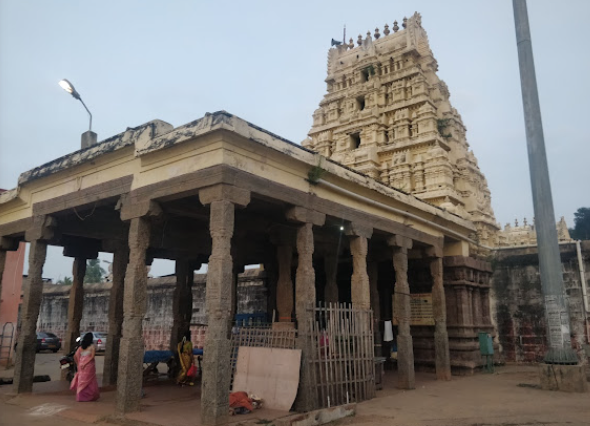In ancient times, the celestial Devas, filled with pride and arrogance, were defeated and driven away by the Asuras (demons). Desperate, the Devas sought refuge at the feet of Lord Vishnu, who resided at Oushadhasala. Promising to aid them, Lord Vishnu assured the Devas of his support.
The Asuras, seeking to consolidate their victory, turned to Lord Shiva for assistance. Lord Shiva also promised his help. Witnessing the Devas' defeat, Lord Vishnu used his discus, Chakrayudha, to vanquish the Asuras and restore the Devas to their rightful place.
To demonstrate his divine nature and appease all, Lord Vishnu manifested as Brahma, Vishnu, and Shiva simultaneously. As the protector and leader of the Devas, he was honoured with the title "Devanatha" (Lord of the Devas).
Recognizing that Lord Vishnu had chosen to remain at this sacred spot, Adishesha, the serpent deity, established a town at this location. This town came to be known as Tiru Ahindi Puram, or Tiruvahindipuram, named after Adishesha, signifying the place where Lord Vishnu chose to stay forever.
Sthala Puranam :
The temple is mentioned in ancient texts like the Brahmanda Purana and Skanda Purana. According to these texts, a group of sages seeking a vision of Lord Vishnu travelled to Thiruparkadal (the Ocean of Milk) and then to Vaikunta, Vishnu’s heavenly abode. They were told that Vishnu could be found in a place close to the shore, north of Kumbakonam, south of Tirupati, and west of Kanchipuram. Upon reaching this location, the sages encountered sage Markandeya and his daughter Bhudevi engaged in penance. Here, Vishnu manifested in His resplendent form, complete with His conch (Sangu) and discus (Chakram).
The temple is associated with a legend involving the Devas and Asuras. The Devas, in their pride, mistreated the Asuras, who then sought Shiva's assistance to combat them. Unable to withstand the battle, the Devas appealed to Vishnu, who defeated the Asuras with His discus. To demonstrate the unity and equality of the divine trinity, Vishnu appeared simultaneously as Shiva (with a third eye and matted locks), Brahma (holding a lotus), and Himself (with His conch and discus).
Another significant legend involves Garuda, Vishnu’s mount, who was tasked with bringing pure water from the Vraja Teertham, a sacred lake under the sage’s supervision. Garuda secretly retrieved the water, which the sage subsequently cursed, making it impure. Vishnu then directed Adisesha, the serpent, to create a well by striking the earth with his tail. The water from this well, known as Sesha Teertham, is still used for temple rituals and is considered equivalent to the Ganga river. The river flowing beside the temple, Garuda Nadi (Kedilam River), flows from south to north and is associated with this sacred water. Due to the sage’s curse, the river water turns red for part of the year.
Significance of Hayagriva :
The temple is notable for its unique shrine dedicated to Lakshmi Hayagrivar, situated on the hillock. Hayagriva, a demon with a horse's head, was defeated by Vishnu, who took on the form of Hayagriva (having a horse's neck) to match the demon's strength. This shrine is believed to be the first of its kind, where Lakshmi is seated on Perumal’s right lap, a rare representation also seen at the Lakshmi Varaha Perumal temple in Tiruvalavendhai.
The temple also features shrines for Rama, Sita, Lakshmana, and other deities. The utsavar (processional deity) is known locally as Moovar Agiyavar, symbolising the divine manifestation of Vishnu as three forms: Shiva, Brahma, and Himself. Both Hanuman and Garuda are depicted with folded palms (Anjali hastam) in the temple.
Legends :
Lord Vishnu manifested his divine presence to several revered figures, including Adhisesha, Sage Markandeya, and Indra.
The Hayagreevar Avatara is not one of the traditional ten avatars of Lord Vishnu. In this form, Lord Vishnu took the incarnation of Hayagreeva to recover the Vedas, which had been stolen. In this Avatara, Vishnu established Saraswati and Brahma as the deities of knowledge and wisdom. Consequently, this place is renowned as a sacred site for seeking blessings for good education.
